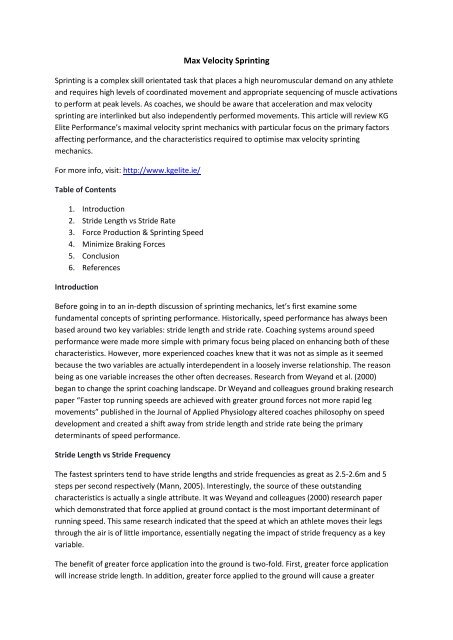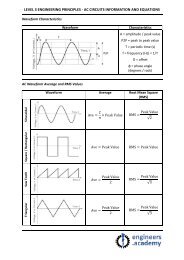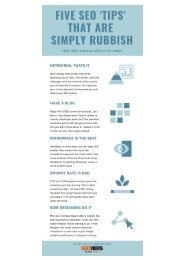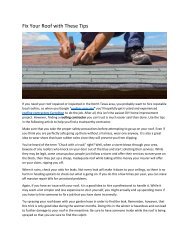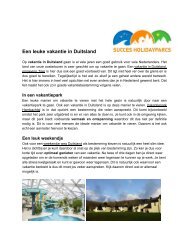Max Velocity Sprinting
http://www.kgelite.ie/ This article will review KG Elite Performance’s maximal velocity sprint mechanics with particular focus on the primary factors affecting performance, and the characteristics required to optimise max velocity sprinting mechanics.
http://www.kgelite.ie/
This article will review KG Elite Performance’s maximal velocity sprint mechanics with particular focus on the primary factors affecting performance, and the characteristics required to optimise max velocity sprinting mechanics.
You also want an ePaper? Increase the reach of your titles
YUMPU automatically turns print PDFs into web optimized ePapers that Google loves.
<strong>Max</strong> <strong>Velocity</strong> <strong>Sprinting</strong><br />
<strong>Sprinting</strong> is a complex skill orientated task that places a high neuromuscular demand on any athlete<br />
and requires high levels of coordinated movement and appropriate sequencing of muscle activations<br />
to perform at peak levels. As coaches, we should be aware that acceleration and max velocity<br />
sprinting are interlinked but also independently performed movements. This article will review KG<br />
Elite Performance’s maximal velocity sprint mechanics with particular focus on the primary factors<br />
affecting performance, and the characteristics required to optimise max velocity sprinting<br />
mechanics.<br />
For more info, visit: http://www.kgelite.ie/<br />
Table of Contents<br />
1. Introduction<br />
2. Stride Length vs Stride Rate<br />
3. Force Production & <strong>Sprinting</strong> Speed<br />
4. Minimize Braking Forces<br />
5. Conclusion<br />
6. References<br />
Introduction<br />
Before going in to an in-depth discussion of sprinting mechanics, let’s first examine some<br />
fundamental concepts of sprinting performance. Historically, speed performance has always been<br />
based around two key variables: stride length and stride rate. Coaching systems around speed<br />
performance were made more simple with primary focus being placed on enhancing both of these<br />
characteristics. However, more experienced coaches knew that it was not as simple as it seemed<br />
because the two variables are actually interdependent in a loosely inverse relationship. The reason<br />
being as one variable increases the other often decreases. Research from Weyand et al. (2000)<br />
began to change the sprint coaching landscape. Dr Weyand and colleagues ground braking research<br />
paper “Faster top running speeds are achieved with greater ground forces not more rapid leg<br />
movements” published in the Journal of Applied Physiology altered coaches philosophy on speed<br />
development and created a shift away from stride length and stride rate being the primary<br />
determinants of speed performance.<br />
Stride Length vs Stride Frequency<br />
The fastest sprinters tend to have stride lengths and stride frequencies as great as 2.5-2.6m and 5<br />
steps per second respectively (Mann, 2005). Interestingly, the source of these outstanding<br />
characteristics is actually a single attribute. It was Weyand and colleagues (2000) research paper<br />
which demonstrated that force applied at ground contact is the most important determinant of<br />
running speed. This same research indicated that the speed at which an athlete moves their legs<br />
through the air is of little importance, essentially negating the impact of stride frequency as a key<br />
variable.<br />
The benefit of greater force application into the ground is two-fold. First, greater force application<br />
will increase stride length. In addition, greater force applied to the ground will cause a greater
displacement of the athlete’s body during mid swing phase causing greater stride length. The second<br />
benefit of increased force application is not so obvious and is often misunderstood. This benefit is<br />
that of increased stride frequency. Therein lies the question, how can increased stride frequency be<br />
caused by increased force application to the ground? Let’s try to simplify things to explain further.<br />
Stride frequency is comprised of two components: ground contact time and flight time. Research on<br />
elite sprinters indicates that the best sprinters spend less time on the ground (Mann, 1986; 2005;<br />
Mann & Herman, 1985). This is because the forces they produce are so great that they enter a<br />
period of flight more rapidly than weaker and slower sprinters. As a result, despite not moving their<br />
limbs significantly faster through the air (Weyand et al., 2000), faster and more skilled sprinters tend<br />
to have greater stride frequency because they reduce the amount of time they spend on the<br />
ground. As a result of an accumulation of research from Mann and Weyand, we now know that<br />
stride length and stride rate are related to max velocity speed performance but are not the primary<br />
causative factors associated with performance.<br />
Force Application & <strong>Sprinting</strong> Speed<br />
If you ask all the successful sprint coaches and biomechanists such as Charlie Francis, Tom Tellez,<br />
Loren Seagrave, Ralph Mann and Peter Weyand, they will all contend that force production and<br />
application is critically important for sprinting performance. Essentially an athlete must increase the<br />
force they apply to the ground and do so over increasingly shorter periods of time. Just as important<br />
as the magnitude of force application however, is the direction of that force application. For<br />
instance, during acceleration athletes attempt to apply large horizontal forces to facilitate braking<br />
inertia and maximising speed off the mark. This results in a large forward lean (45°-60° subject to<br />
sprinting on track or pitch).<br />
During max velocity sprinting, athletes should attempt to minimise braking forces and increase<br />
vertical propulsive forces. Vertical propulsive forces are important because once momentum has<br />
been maximally developed during the acceleration period, the body will tend to keep moving<br />
forward at the same speed as long as the internal and external forces acting on the body are<br />
balanced. With more vertical force generation, more time will be spent in the air which will allow the<br />
athlete to reposition their limbs more effectively for the next ground contact.<br />
With these fundamental concepts in mind, what can coaches do to maximise max velocity sprint<br />
performance? From my perspective and all the tutors at Elite Performance Institute (EPI), we focus<br />
on three primary areas:<br />
1. Develop the force-velocity curve<br />
2. Focus on direction of force application<br />
3. Optimise sprinting mechanics<br />
We assess all aspects of the the athlete’s FV curve to identify any limitations. For max velocity<br />
sprinting, these can include speed-strength and fast stretch shortening cycle (SSC) qualities. We then<br />
prioritise vertical force production exercises for both the FV curve development as well as speed<br />
mechanics.
Minimise Braking Forces<br />
Another key objective of efficient sprinting is minimizing braking forces that the athlete encounters<br />
at ground contact. Braking forces refer to those forces which act in the opposite direction of the<br />
desired movement. Carl Lewis was often thought to be getting faster as they ran past 60m, he simply<br />
decelerated less than his competitors. In comparison to this, one of his competitors Desai Williams<br />
(one of Charlie Francis athletes), would accelerate exceptionally well but would traditionally<br />
decelerate very poorly in the final 30-40m of a race. A prime example of this was in the 1988 Seoul<br />
Olympics when he was second to Ben Johnson for the first forty meters, but only finished 7th by the<br />
end of the race (Ray Stewart tore his hamstring early in race and hobbled over the finish line in 8th).<br />
The primary cause of excessive braking forces is making ground contact too far in front of the<br />
athlete’s center of mass (an athlete’s center of mass is roughly located in the vicinity of their hips).<br />
Why one athlete applies more braking forces at maximal velocity than another is difficult to say and<br />
is often multi-factorial than one simple isolated reason. Ideally, an athlete should minimise the<br />
horizontal distance between their center of mass and the point of ground contact. In simple terms,<br />
they need to strike the ground directly under their hips and not out in front of their body. Why do<br />
they do it? Often it is an veiled attempt to attain further maximal velocity rather than accepting they<br />
have reached their maximal speed and switch their focus to maintaining it with appropriate speed<br />
mechanics. Another reason is because they attempt to increase their force production in an effort to<br />
increase their stride length with the hope of increased velocity. Regardless of the reason, unfolding<br />
the tibia and stretching the leg out in front of the body with each step in an attempt to increase<br />
stride length will only increase horizontal braking forces, increase ground contact time and slow the<br />
athlete down.<br />
Just watch Usain Bolt in the video below and how well he strikes under his COM during stance<br />
phase.<br />
Conclusion<br />
<strong>Max</strong> velocity sprinting performance is maximized when the largest possible forces are applied to the<br />
ground in appropriate directions over very short periods of time. From a coaching perspective, an<br />
athlete should optimise their force production through appropriate strength training and speed<br />
mechanics training. In addition, they should look to minimise braking forces and increase vertical<br />
propulsive forces. On KG Elite Performance Strength & Conditioning courses, we assess our athletes<br />
using our speed mechanics assessment which involves assessing front-side and back-side mechanics.<br />
The goal of the athlete is to minimise poor backside mechanics and enhance front-side mechanics.<br />
Finally outside of these technical points, FV curve needs to be developed with accessory work on<br />
gluteal and hamstring strength along with enhancing tendon stiffness to facilitate greater utilisation<br />
of stored elastic energy during ground contact.<br />
References<br />
1. Mann, R. (1986). The biomechanical analysis of sprinters. Track Technique, 3000-3003.<br />
2. Mann, R. (2005). The Mechanics of <strong>Sprinting</strong>. CompuSport: Primm, NV.<br />
3. Mann, R. and Herman, J. (1985) Kinematic analysis of Olympic sprint performance: men’s<br />
200 meters. International Journal of Sport Biomechanics, 1, 151-162.
4. Mann, R.A., and Hagy, J. (1980). Biomechanics of walking, running, and sprinting. American<br />
Journal of Sports Medicine, 8(5), 345-350.<br />
5. Weyand, P., Sternlight, D., Bellizzi, M. and Wright, S. (2000). Faster top running speeds are<br />
achieved with greater ground forces not more rapid leg movements. Journal of Applied<br />
Physiology, 89, 1991-2000.


